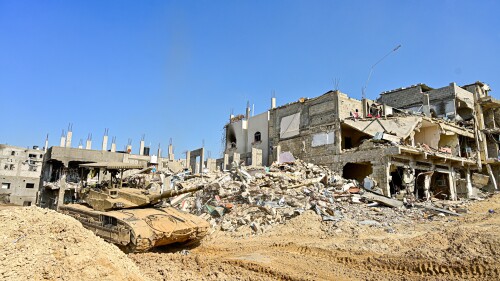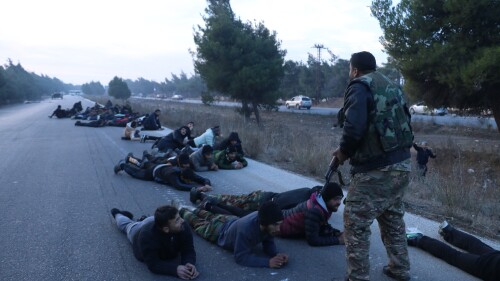Palestinians stand on the remains of the house of PFLP operative Qassem Shibli near Ramallah after its demolition by the IDF earlier this month. (FLASH90) |
The Israel Defense Forces this week carried out the partial demolition of the home of Qassem Shibli, also known as Qassem al-Barghouti, in the village of Kobar, in the Ramallah area. Shibli is suspected of involvement in the murder of Rina Shnerb, 17, who was killed in an IED detonation at the Ein Bubin spring near the community of Dolev, on August 23, 2019.
This house demolition is the latest move by the Israeli authorities against a Palestinian terror network in the West Bank maintained by the Popular Front for the Liberation of Palestine (PFLP.) Following the murder of Rina Shnerb, the authorities rounded up around 50 members of the alleged network, and uncovered large amounts of weaponry and explosives. Those apprehended included ground level operatives, such as Qassem Shibli, and known, senior PFLP activists. The network was headed by Walid Muhammad Hanatsheh, according to statements by the Israeli authorities. Samer Arbid commanded the cell which carried out the Dolev attack. Khalida Jarrar, a known and senior PFLP leader in the West Bank, was also among those arrested.
PFLP operatives arrested in connection with the Shnerb murder include (clockwise from top left) Nizam Mahmoud, Qassem Shibli, Yasan Majamas, Samer Arbid, Walid Hanatsheh, Abdel Raziq Faraj, Khalida Jarrar and Itaraf Hajaj. (Shin Bet) |
These events are particularly notable in that they turn the spotlight on the current re-energised activities of the PFLP. Long regarded as a Cold War fossil, the organization has in recent months re-emerged to some modest prominence. What is the reason for the increased capacities and activity of the PFLP in the recent period?
The explanation is not to be found in any change of sentiment at grassroots level among the Palestinian population. Like other secular Arab nationalist factions, the PFLP has never enjoyed wide public support. Rather, the complex and shifting geo-politics of the Middle East have resulted in increased resources becoming available to the PFLP in recent years. These have in turn led to the uptick in its activities.
Observation of another legal case currently under way reveals evidence of the specific source from which the PFLP appears to be drawing benefit.
In early April, an Israeli citizen of Arab ethnicity, Ayman Haj Yihye, 50, was indicted at Lod District court, accused of a number of serious security offences. These included, according to the indictment: Contact with a Foreign Agent – An offense under section 114 (a) of the Penal Code, and delivering information to the enemy with intent to harm state security – an offense under section 111 (middle) of the Penal Code. He was also charged with money laundering and an attempt to disrupt a judicial investigation.
According to the indictment, Haj Yihye had met with and begun cooperation with two operatives of Iranian intelligence, (identified as ‘Abu Samah’ and ‘Abu Hussein’ in the indictment,) with the intention of ‘assisting the State of Iran in its efforts to harm the State of Israel through the gathering of information in the areas of intelligence, security, political, civil, social and media, which could be of assistance to Iran in its war against the State of Israel.’
The individual who recruited Haj Yihye for this purpose is identified by the indictment as Khaled Yamani, a Palestinian resident of the Baddawi refugee camp in Lebanon and a well-known and senior member of the PFLP.
That is, the PFLP activist Khaled Yamani appears to be doubling as a recruiter and operative for the intelligence services of Iran. Yamani’s dual role raises an additional interesting point regarding the PFLP: unlike their Islamist counterparts, the group does not appear to different organizationally between clandestine military activity and open political work. Yamani, as well as Arbid, Hanatsheh and Jarrar, appear to have been engaged simultaneously in both.
The PFLP has returned to relevance because of its burgeoning relationship with Iran.
The details of this indictment show the clearest evidence currently available in the public domain of the specific force behind the present revival of the formerly moribund PFLP. The movement has returned to relevance in recent months because of a burgeoning relationship developed with the Islamic Republic of Iran.
This growing PFLP-Iran connection is not a new revelation. It has been well reported in recent years. As long ago as September, 2013, an article in Al-Monitor by Gaza based Palestinian journalist Hazem Balousha noted the growing ‘financial and logistical’ support from Teheran to the PFLP’s ‘political and military wings.’
According to Balousha’s report, a number of meetings between Iranian and PFLP officials were held in Beirut, Damascus and Teheran. The meetings, according to Balousha, were brokered by Lebanese Hizballah. They resulted in the revival of direct Iranian support for the PFLP.
The Palestinian journalist quoted a ‘senior PFLP source,’ who predicted that “Following the resumption of Iranian support, there will soon be a dramatic increase in the strength of the PFLP’s military wing, the Abu Ali Mustafa Brigades, after the internal reorganization of the group is completed.”
The aforementioned reorganization has evidently taken place.
What was the reason for Islamist Teheran’s decision to commence support for the ostensibly secular and leftist PFLP?
Firstly, the supposed leftist or ‘progressive’ credentials of the PFLP should not be exaggerated. The movement’s founder, Dr. George Habash, found it opportune to declare himself a ‘Marxist-Leninist’ in the late 1960s, at a time when Soviet weapons and funding were available to those professing such allegiances.
Prior to this period, Habash had founded and led the Arab Nationalist Movement, a Nasserist organization. Habash’s ostensible turn to the left did not damage his close association with one Francois Genoud, a prominent European neo-Nazi financier who provided monetary support and assistance to the nascent PFLP.
This ancient history is of importance because it demonstrates the opportunism and ideological flexibility of the PFLP on all matters other than its real, openly professed business – violent activity toward the destruction of Israel. This is the element of interest to the Iranians.
The Syrian civil war led to a rupture between Teheran and the Palestinian Hamas movement.
But the specific reason for Iran’s renewed support for the PFLP relates to the Syrian civil war. The clash between the Iran-supported Assad regime and the largely Sunni Islamist insurgency led to a rupture between Teheran and the Palestinian Hamas movement which has not been entirely repaired. Hamas, which emerged from the Palestinian branch of the Muslim Brotherhood, strongly supported the Syrian rebellion. It maintains close relations today with Qatar and Turkey, and finds its natural home in the Sunni Islamist nexus supported by these states.
The (partial) loss of Hamas, combined with the difficulty for Hamas of building armed networks in the West Bank because of Israeli and PA attention, has led Teheran to look further afield.
The PFLP’s position on Syria was consistent and unambiguous: it strongly supported Assad throughout the war. When the regime re-took Aleppo in late 2016, the movement’s website declared the victory to be ‘“the start of the retreat of the plot against our Arab nation and the thwarting of the reactionary imperialist Zionist plan”.
Like Islamic Jihad, Teheran’s long standing proxy among the Palestinians, the PFLP is a small organization with a somewhat eccentric ideology possessing little appeal among the broad masses of the conservative, religious Palestinian population. It possesses, nevertheless, a tight organizational structure, a cadre of fiercely loyal militants and a willingness to engage in violence. It now appears that Teheran’s steady investment in the movement over the last half decade has begun to deliver results.
Jonathan Spyer is director of the Middle East Center for Reporting and Analysis and is a research fellow at the Middle East Forum and at the Jerusalem Institute for Security and Strategy.









